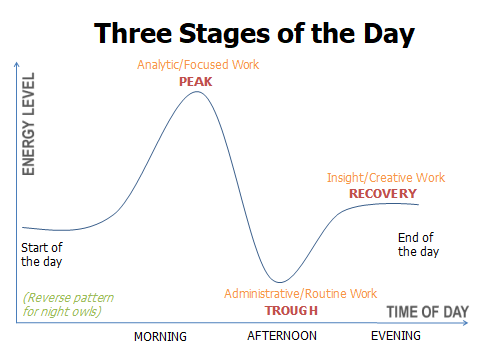
Chronotype-based scheduling
When we do something can be just as important as what we do. Our cognitive abilities fluctuate predictably throughout the day based on our circadian rhythms. Understanding your personal chronotype—whether you're a morning person (early), a night person (late), or somewhere in between—can help you optimize your schedule for peak performance.
Understanding Chronotypes
Our bodies follow natural cycles that affect our alertness, focus, creativity, and decision-making abilities throughout the day:

Research has identified that most people fall into one of three main chronotype categories, with each experiencing energy phases at different times:
| Chronotype | Peak | Trough | Recovery |
|---|---|---|---|
| Morning Person (Early) | Early Morning | Early Afternoon | Evening |
| Intermediate | Late Morning | Mid-Afternoon | Evening |
| Night Person (Late) | Late Evening | Late Morning | Early Morning |
Optimizing Your Schedule
Match your activities to your energy levels for maximum effectiveness:
| Activity | When to Schedule |
|---|---|
| Analytical Work | Peak |
| Creative Work | Recovery |
| Important Meetings | Peak |
| Administrative Tasks | Trough |
| Strategic Planning | Peak |
| Learning New Material | Peak |
| Routine Tasks | Trough |
| Brainstorming | Recovery |
| Short Nap (20 min) | Trough |
Common mistakes to avoid:
- Scheduling critical tasks during your trough
- Back-to-back meetings during low-energy periods
- Consuming caffeine during your natural peak
- Ignoring your body's signals
Adapting When Your Schedule Doesn't Match Your Chronotype
When external factors force you to work against your natural rhythms:
-
Manage light exposure
- Bright light during desired wake hours
- Limit blue light before sleep (research shows blue light can suppress melatonin production)
-
Strategic caffeine use
- Time intake 30-60 minutes before needed alertness
- Avoid within 8-10 hours of bedtime (caffeine has a half-life of approximately 5-6 hours)
-
Maintain sleep consistency
- Keep regular sleep-wake times even on weekends
- Create a wind-down routine
-
Batch similar tasks
- Group activities that require similar energy levels
- Schedule your most important work during your biological prime time
Finding your chronotype is simple: note when you naturally wake up without an alarm, when you feel most alert, and when you experience energy dips. This awareness allows you to work with your body's natural rhythms rather than against them.
Scientific Basis
The concept of chronotypes is supported by research in chronobiology and sleep science. Studies have shown that individual differences in circadian timing are influenced by genetic factors and can significantly impact cognitive performance throughout the day. While these patterns are somewhat flexible, understanding your natural tendencies can help you make more informed scheduling decisions.
Further Reading
For those interested in exploring chronotypes and circadian science further:
-
When: The Scientific Secrets of Perfect Timing by Daniel H. Pink - Highly motivated this blog post
-
The Power of When by Dr. Michael Breus - A comprehensive guide to chronotypes and optimizing your schedule
-
Society for Research on Biological Rhythms - Scientific organization dedicated to circadian rhythm research
-
Sleep Foundation: Chronotypes - Evidence-based overview of chronotypes and sleep patterns
These resources provide scientific evidence and practical applications for understanding and working with your natural chronotype.
02/23/2025
back to blog